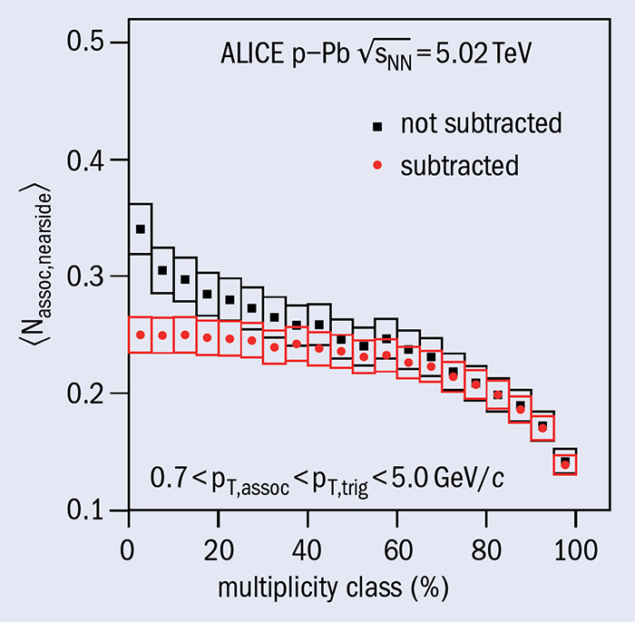
One of the hottest topics at the LHC is the understanding of potential collective effects in proton–lead collisions, prompted by the discovery of ridge structures in angular correlations of particles (CERN Courier January/February 2013 p9). Further insight is expected from studying the role of multiple parton–parton interactions, as well as from investigating the interplay of these ridge structures with jet structures caused by (semi)hard scatterings. A new study by the ALICE collaboration has characterized minijets – jet-like structures in the regime of low transverse momentum (pT) where the ridge has been observed – to shed light on particle-production mechanisms.

The analysis looks at event activity, characterized by particle multiplicity measured at large rapidity. The jet-like correlations are determined by counting the number of associated particles as a function of their difference in azimuth (Δφ) and pseudorapidity (Δη) with respect to a trigger particle. The minijets reveal themselves as a peak on the “near side” (Δφ = 0, Δη = 0) and an elongated structure in Δη on the “away side” (Δφ = π) on top of the double ridge. The ridge structures themselves are found on the near and away side to be independent of Δη and almost symmetric around π/2. The projection of the correlations onto Δφ makes it possible to quantify the particle production in semi-hard processes. The number of particles in the minijets is given by the integral under the peaks and above the background originating from the underlying event.
The black points in the figure show that the average near-side yield per trigger particle increases from the lowest (95–100%) to the highest (0–5%) event-multiplicity class. To separate the jet-like peak structures from the ridge, the contribution from the near-side ridge can be estimated at large Δη, where the jet-like correlations are absent. Owing to the approximate symmetry around π/2, the near-side ridge is mirrored into the away-side region and subtracted from both sides of the correlation function. Non-symmetric components (e.g. cos 3Δφ) have only small effects limited to the away side. The red data points in the figure show the near-side yield after this ridge subtraction.
While it is not surprising to find agreement between the yields with and without ridge subtraction in the 60–100% event-multiplicity classes, where no significant ridge structures exists, qualitative differences emerge in the 60% highest multiplicity. In this region, there is no dependence on event activity for jet-like per-trigger yields (i.e. after ridge subtraction). This suggests that the hard processes, which are the sources of associated particles, and the soft processes, which together with the hard ones are at the origin of the trigger particles, scale with the same factor with multiplicity. These observations are consistent with a scenario where the minijet yield stems from an incoherent fragmentation of multiple parton–parton scatterings, while the double ridge is not jet related and is additive to the minijets.







